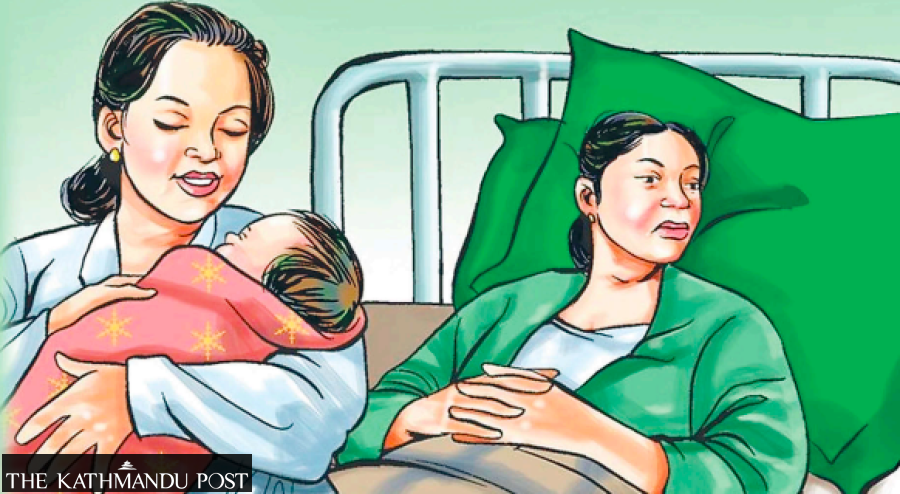Health
190 women from 51 districts died from birth-related complications last fiscal year
Health officials say that the actual number of maternal deaths may be much higher, as surveillance is limited to just 51 districts.
Arjun Poudel
At least 190 women from 51 districts died of complications during childbirth in the fiscal year 2023-024, data provided by the Family Welfare Division under the Department of Health Services show.
The actual number of maternal deaths due to birth-related complications could be much higher, as maternal and perinatal death surveillance is being carried out in 51 districts only, officials say.
“Maternal deaths from childbirth-related complications could be significantly underreported, as we are only tracking cases in 51 districts,” said Nisha Joshi, a public health official at the division. “We have no data on maternal and perinatal deaths in the rest of the districts.”
In the fiscal year 2022-023, 191 maternal deaths were recorded across 49 districts.
Nepal reduced the maternal mortality rate from 239 per 100,000 births in 2016 to 151 per 100,000 in 2021, according to the national census carried out by the National Statistics Office.
Earlier, the country had reduced the maternal mortality rate from 539 per 100,000 births in 1996 to 239 per 100,000 births in 2016—for which the country even received a Millennium Development Goals award.
The health target under the UN’s Sustainable Development Goals is to reduce the maternal mortality rate to 75 per 100,000 births by 2030.
The latest census report has shown that 622 maternal deaths were recorded in a year. Officials at the Health Ministry concede that the number of deaths reported from 51 districts is only around 30 percent of the total maternal deaths occurring across the country.
They complained that the lack of maternal and perinatal death surveillance programmes in all districts is the main reason for the underreporting of maternal deaths.
“Due to budget constraints, we could not expand the maternal and perinatal death surveillance to other districts this year,” said Joshi. “We also have problems in the reporting system, and deaths that occur in villages of the districts without surveillance programmes go unreported.”
Maternal health experts say that concerned authorities are keeping themselves in the dark by not conducting studies in all districts.
“Without knowing the actual situation, effective planning is not possible, which means efforts to reduce ongoing deaths may not succeed,” said Dr Ganesh Dangal, a maternal health expert. A huge budget is not necessary to carry out death surveillance. So this programme should be enforced mandatorily in all districts immediately.”
Maternal and perinatal death surveillance is a key intervention for improving maternal, perinatal, and neonatal survival rates. Experts say such surveillance provides an understanding of the number and causes of deaths, enabling more targeted and effective interventions.
Nepal strives to reduce the deaths of mothers and babies. However, it lacks maternal and perinatal death surveillance in all districts.
Perinatal death is the death of a baby between 22 weeks of gestation (or weighing 500g) and seven days after birth.
The World Health Organisation said that maternal and perinatal death surveillance and response (MPDSR) is an essential quality improvement intervention, which permits the identification, notification, quantification and determination of causes and avoidability of maternal and neonatal deaths and stillbirth to orient the measures necessary for their prevention.
According to the UN health body, systematic analyses of overall mortality trends and events and contributing factors leading to individual deaths can identify barriers in health systems and inspire local solutions to prevent such deaths in the future.
Studies carried out in the past show that excessive bleeding after childbirth, pre-eclampsia and eclampsia (pregnancy-related high blood pressure disorders) are some of the reasons for maternal deaths.
The World Health Organisation said postpartum haemorrhage is the leading cause of maternal mortality in low-income countries and the primary cause of nearly a quarter of all maternal deaths globally. Most deaths resulting from the said complication occur during the first 24 hours after birth.
Gynaecologists say tears in the cervix or tissues of the vagina, tear in a blood vessel in the uterus, bleeding in hidden tissue area or space in the pelvis, blood clotting disorders, and placenta problems are among the causes of postpartum haemorrhage.
Every year, over 600,000 women deliver babies in Nepal.




 23.12°C Kathmandu
23.12°C Kathmandu















